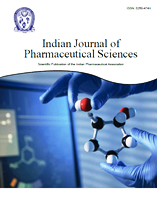- Corresponding Author:
- R. S. Verma
Central Institute of Medicinal and Aromatic Plants (CIMAP, CSIR), Research Centre, Pantnagar, P.O.- Dairy Farm Nagla, Udham Singh Nagar, Uttarakhand-263 149
E-mail: rswaroop1979@yahoo.com
| Date of Submission | 19 May 2010 |
| Date of Revision | 17 February 2011 |
| Date of Acceptance | 17 March 2011 |
| Indian J Pharm Sci, 2011, 73 (1): 233-235 |
Abstract
Thymus serpyllum L. grown in Kumaon region of Western Himalaya was investigated for essential oil content and composition in different seasons. The oils of fresh samples were obtained by hydrodistillation. The yield of essential oil (% v/w) during different seasons varied from 0.07 to 0.28% with the highest in summer season, at vegetative stage. The oils were analyzed by GC and GC-MS. Major components of all the samples were thymol (19.4-60.1%), γ-terpinene (0.3-13.8%) and p-cymene (3.5-10.4%). The results clearly indicated that season has significant effect on quality and quantity of thyme oil.
Keywords
Composition, essential oil content, seasonal variation, Thymus serpyllum, thymol, γ terpinene
The genus Thymus L. (Lamiaceae) consists of about 215 species of herbaceous perennial and subshrubs. The Mediterranean region can be described as the centre of the genus [1]. In India, T. serpyllum is distributed from Kashmir to Kumaon Himalaya [2]. Thymus species are well known as medicinal plants due to their biological and pharmacological properties [1,3]. It is commonly used as tonic, herbal tea and flavoring agent. Thymus oils and extracts are widely used in pharmaceutical, cosmetic and perfume industry also for flavoring and biopreservation of several food products [4]. Although the chemical composition of essential oils from different Thymus species have been reported from various countries [5-10]. However, the report on chemical composition of T. serpyllum from India is still very little [11,12]. Variation in chemical composition of essential oils may be observed due to the origin, the environmental conditions and the developmental stage/season of collected plant materials [13,14]. Considering the importance as a source of phenolic and non phenolic monoterpenoids [9,15-18] and paucity of studies from this region prompted us to investigate the proper harvesting stage/season for getting better essential oil content and composition of T. serpyllum.
The planting of T. serpyllum was done in the month of October and plants raised following normal agricultural practices in the experimental field of Central Institute of Medicinal and Aromatic Plants, Research Center, Purara, Uttarakhand. The site is located between the coordinates 280 60’ to 310 29’ N, 770 49’ to 800 60’ E and at a height of 1250 m in Kattyur valley. Climatologically, it is categorized as sub temperate (1200-1700 m) zone. The monsoon usually breaks in June and continues up to September. The aerial parts of T. serpyllum were collected during different seasons viz. spring, summer, rain, autumn and winter and were immediately subjected to hydrodistillation in Clevenger type apparatus for 3 h to obtain the essential oil. The oil volume was measured directly in the extraction burette. Content (%) was calculated as volume (ml) of essential oil per 100 g of fresh plant material. The oils were dried over anhydrous sodium sulphate and stored at 50 in a refrigerator (to minimize the loss of volatile compounds) prior to analysis.
GC and GC-MS analysis of the essential oils was performed under the experimental conditions reported earlier [12]. Identification of constituents was based on retention times, retention indices, and MS Library searches (NIST and WILEY) [19,20].
Essential oil content was found higher in summer season (0.28%) followed by rain (0.25%) and spring season (0.18%), whereas it was 0.17% and 0.07% during autumn and winter season, respectively. This pattern of oil accumulation in T. serpyllum showed that the dynamics of the essential oil content appears to be metabolically regulated during vegetative and flowering stages of crop growth. However, oil content was lower at flowering stage compared to vegetative stage (summer). This was due to higher internodal length (12.8 mm) resulting lower leaf/stem ratio (2.59) during flowering stage while vegetative stage (summer) resulted lower internodal length (10 mm) and higher leaf/stem ratio (3.48). On setting of seeds during autumn the essential oil decreased further possibly due to deterioration of oil glands. Variation in essential oil content due to phenological stage of the plant is also reported in Thymus caramanicus [14]. GC and GC-MS results showed that the T. serpyllum oil is mainly composed of oxygenated monoterpenes (51.3- 77.2%) followed by monoterpene hydrocarbons (8.5- 27%). The major components of the oils are thymol, p-cymene, γ-terpinene, 1-octen-3-ol, thymol methyl ether, carvacrol methyl ether, borneol, and p-cymen-8- ol. Thymol reached the highest values during autumn (60.1%) seasons while during the rest of the year its concentration ranged from 19.4% to 56.4% with the lowest in winter. However, the percentage of p-cymene and γ-terpinene, precursor of thymol [21] was higher in winter (10.4%) and spring (13.8%), respectively. Further, concentrations of these two constituents during rest of time range between 3.5-5.9% and 0.3-13.6%, respectively. On the other hand, 1-octen-3-ol (2.5- 6.5%), linalool (0.4-1.0%), thymol methyl ether (3.1- 8.7%), carvacrol methyl ether (3.2-6.4%), borneol (1.8- 11.6%) and caryophyllene oxide (0-3.6%) reached the higher values in winter followed by autumn season. The concentration of other components like α-pinene (0.3-2.1%), β-myrcene (0-1.6%), α-terpinene (0-1.8%), β-caryophyllene (0.3-1.2%), p-cymen-8-ol (0.4-2.6%) and carvacrol (0.5-1.3%) were also found to influence by harvesting season. Variation in the concentration of thymol, p-cymene, g-terpinene and other constituents of T. vulgaris due to season of harvesting is reported from Brazil where higher oil content and oxygenated compounds were found in spring [22].
On the basis of these results it is concluded that harvesting season had considerable effect of essential oil yield and composition of T. serpyllum growing in Kumaon region of western Himalaya. Therefore, harvesting of T. serpyllum should be done in summer season to achieve better essential oil yield.
Acknowledgements
Authors thank the Director, Central Institute of Medicinal and Aromatic Plants (CIMAP), Lucknow, Uttar Pradesh for providing financial support under Young Scientist Project (YSP09.19).
References
- Stahl-Biskup E, Saez F. Thyme. The genus Thymus. London: Taylor and Francis; 2002.
- Mukerjee SK. A revision of the Labiatae of the Indian empire. Rec Bot Surv India 1940;14:93.
- Davidson PM, Naidu AS. Phyto-phenols. In: Naidu AS, editor. Natural food antimicrobial systems. Boca Raton FL: CRC Press; 2000. p. 265-294.
- Bauer KD, Grabe H, Surburg H. Common fragrance and flavour materials. Weinheim, Germany: Wiley-VCH Verlag; 1997.
- Lawrence BM. Progress in essential oils. Perf Flav 1981;23:63-82.
- Lawrence BM. Progress in essential oils. Perf Flav 1998;6:27-34.
- Garcia-Martin D, Garcia-Vallejo MC. Chemotypes of Thymus zygis(Lofl.) L., of Guadarrama Sierra and other places in Castile (Spain). 9th International Congress of Essential oils, Mandarin Court B, Singapore;14-17 March 1983.
- Sajjadi SE, Khatamsaz M. Composition of the essential oil of Thymusdaenensis Celak. Sp lancifolium (Celak) Jalas. J Essent Oil Res2003;15:34-5.
- Mockute D. 1,8-Cineole - Caryophyllene Oxide Chemotype ofEssential Oil of Thymus serpyllumL. Growing Wild in Vilnius(Lithuania). J Essent Oil Res 2004;16:236-8.
- Nickavar B, Mojab F, Dolat-Abadi R. Analysis of the essential oils of two Thymus species from Iran. Food Chem 2005;90:609-11.
- Mathela CS, Agarwal J, Taskinen J. Composition of essential oil of Thymus serpyllum Linn. J Ind Chem Soc 1980;57:1249-50.
- Verma RS, Rahman L, Chanotiya CS, Verma RK, Singh A, Yadav A, et al. Essential oil composition of Thymus serpyllum cultivated in the Kumaon region of western Himalaya, India. Nat Prod Commun 2009;4:987-8.
- Kulevanova S, Ristic M, Stafilov T, Dorevski K, Ristov T. Essential oil analysis of some taxa of genera ThymusL. - environmental influences. Bull Chem Technol Macedonia 1996;15:33-8.
- Ebrahimi SN, Hadian J, Mirjalili MH, Sonboli A, Yousefzadi M. Essential oil composition and antibacterial activity of Thymus caramanicus at different phenological stages. Food Chem 2008;110:927-31.
- Loziene K, Vaiciuniene J, Venskutonis PR. Chemical composition of the essential oil of creeping thyme (Thymus serpyllum s.l.) growing wild in Lithuania. Planta Med 1998;64:772-3.
- Raal A, Paaver U, Arak E, Orav A. Content and composition of the essential oil of Thymus serpyllum growing wild in Estonia. Medicina (Kaunas) 2004;40:795-800.
- Sefidkon F, Dabiri M, Mirmostafa SA. The composition of Thymusserpyllum L. oil. J Essent Oil Res 2004;16:184-6.
- Paaver U, Orav A, Arak E, Maeorg U, Raal A. Phytochemical analysis of the essential oil of Thymus serpyllum L. growing wild in Estonia. Nat Prod Res 2008;22:108-15.
- Jennings W, Shibamoto T. Qualitative analysis of flavour and fragrance volatile by glass capillary gas chromatography. New York: Academic Press; 1980.
- Adams RP. Identification of essential oil components by gas chromatograph/mass spectrometry. Carol Stream, USA: Allured Publishing Corporation; 1995.
- Poulose AJ, Croteau R. Biosynthesis of aromatic monoterpenes-conversion of gamma-terpinene to para-cymene and thymol in Thymusvulgaris L. Arch Biochem Biophys 1978;187:307-14.
- Atti-Santos AC, Pansera MR, Paroul N, Atti-Serafini L, Moyna P. Seasonal variation of essential oil yield and composition of Thymus vulgaris L. (Lamiaceae) from south Brazil. J Essent Oil Res2004;16:294-5.




